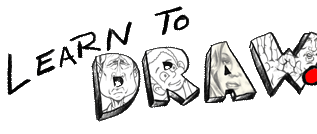 |
 |
|
Some foreshortening images |
If an object has three dimensions - Height, Width and
Depth - that object can get foreshortened in drawing.
Foreshortening occurs when you're representing a three
dimensional object on a two dimensional drawing plane
and you want to show all three of those dimensions. In
order to do this you have to create the illusion of the
third dimension by foreshortening the object. When something gets foreshortened proper proportion is
nullified. Foreshortening is when an object appears to
be receding into the paper or coming straight at you
directly out of the plane of the paper. When this
happens, the size of the object is distorted or
shortened, to make it
appear that an object is closer to you than the other
objects in the drawing. Foreshortening then, is
intentionally skewing proportion in order to get a 3-D
look in a drawing. To show that the elements of
drawing all hang together - in the
1 & 2 Point
Perspective exercises you were creating
foreshortening already! The sides of the boxes that receded
from the front to
the back are foreshortened. Those were
simple drawings so the foreshortening in them was
simple. The more complex an object or a scene becomes,
the more complex the foreshortening becomes.
 |
|
A Pointing finger |
 |
 |
|
Don't do this if
it's not there. |
Foreshortening can be difficult for some people
because since the proportions get skewed sometimes the
object no longer looks like the object that you
are drawing. It's at this point that your logical mind
kicks in and says to you that what you are drawing
doesn't look like what you're drawing. What your logical
mind cannot grasp is that it's not supposed to
look like what you are drawing because the
foreshortening distorts the object. A good example of
this is a hand with a pointing finger coming straight at
you. The hand looks all right but the pointing finger
looks weird. The reason it looks weird to you is because
it no longer looks like a finger to your logical mind.
Fingers are supposed to be long and skinny things and
this looks short and stubby - so your brain says it's
not a finger. So if you'd want to draw the hand to the
right, you'll have to ignore your logical mind and rely
on your artistic mind. (you should be doing that already
when you're drawing) So the way many people deal with
the pointing finger is to not draw what they see and
draw a finger from the side even though the finger is
not from the side but straight on. So if you want to
draw the finger as you see it, you'll have to ignore
your logical mind screaming at you that what you're
drawing is incorrect and really draw what you see. Draw
the lines, shapes, spaces, shadows and measure what you
see and the drawing will be correct. A lot of what makes
a foreshortened object look correct is context. On it's
own a pointing finger may not look like a finger at all
- but once you put the rest of the hand into your
drawing then it will look like a pointing finger because
your brain will connect the finger to the rest of the
hand and then it will understand that it's a pointing
finger.
 |
|
Your finger is like a tube. |
 |
 |
|
Drawing a pointing finger |
Your fingers are basically cylinders - like a
cardboard bathroom tissue roll. So if you look at the
cardboard roll from the side and slowly turn it so that
you're looking down through it - you'll begin to
understand a pointing finger. Better yet, look at your
own finger. First look at it from the side and see your
knuckles, down to the first joint, then the second, then
the tip of the finger. Now look again at the first joint
and slowly turn your hand towards your face still
looking at the first joint. Watch how the look of the
joint changes as you turn your hand. You'll see what the
first joint looks like when you're looking straight down
your finger. Now do that same turning idea with the
other parts of the finger and see how they change as you
turn your hand. This is the best way for your logical
mind to understand what a foreshortened object looks
like - by showing the brain how it changes as the angle
of the object changes. So if you wanted to draw the
pointing finger, draw what you see and ignore the fact
that it's a finger. Begin by looking at the photo and
studying the lines and shapes and spaces that you see.
More foreshortening concepts will be explored elsewhere
in the website. |
